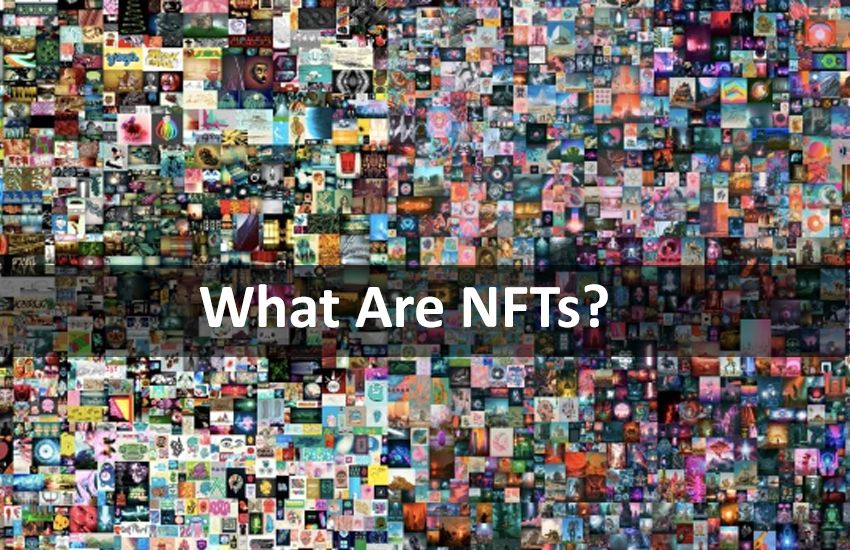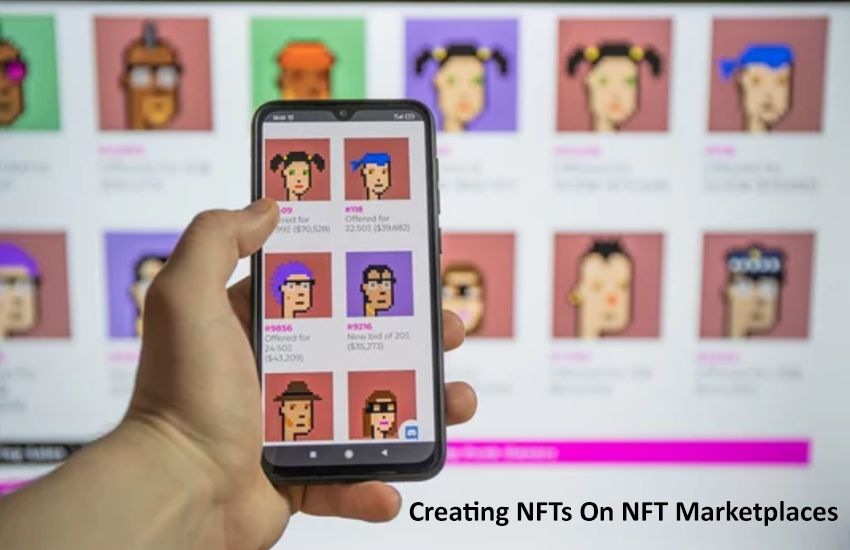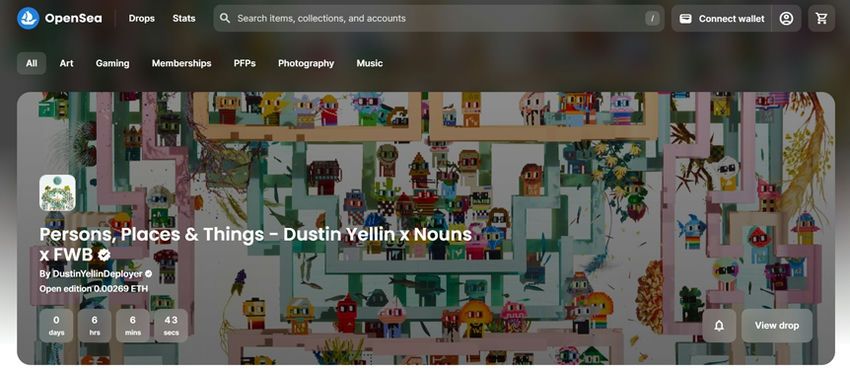Non-fungible tokens (NFTs) have generally been associated with the newest trend in investing, but they can also be creative and successful tools for artists from many walks of life.
Although selling digital files is nothing new, NFTs enable artists to produce their digital artwork and sell it directly from their decentralized NFT marketplaces without the need for negotiating agents.
What Are NFTs?
A domain name, an audio or video clip, a jpeg file, or another sort of digital asset that is created on the blockchain can all be NFTs.

For the time being, there are no legal constraints on who can download and preserve an NFT, much like who can buy a copy of a famous physical painting. They cannot, however, assert ownership over a specific NFT because that NFT always belongs to its original owner or the current owner.
The process of converting your writing into an NFT and posting it on the blockchain is known as minting. It can be a successful strategy for artists to make money off their works.
They can also decide on a commission or charge for upcoming sales of the artwork and accumulate passive income over time, similar to a royalty that is typically between 10% and 30%, which is not possible in the traditional art trade.
How Hard Is It to Create an NFT?
Making an NFT does not involve any coding or technological knowledge. Because of the technology’s quick and widespread adoption, blockchain-based NFT marketplaces like OpenSea have assured that simple mechanisms are in place to allow users to effortlessly generate and trade NFTs.
Blockchain technology may be scary to the less tech-savvy individual. However, this post will highlight the finest tools for novices to get started with NFT minting and their differences.
The Best Tools to Mint NFTs
Which Blockchain To Mint On?
Let’s start with the blockchains that will be used to store your NFT. Once you’ve decided which service is best for you, you’ll need to purchase a blockchain’s native cryptocurrency. You can purchase (or sell) cryptocurrencies on any crypto exchange in your country. The most popular are Coinbase and Binance.
You can mint your NFT directly on the blockchain, but this is a procedure best left to tech-savvy individuals. To use APIs, construct smart contracts, and understand coding, there are various steps to take and some technical knowledge.
Ethereum is the most commonly used blockchain for issuing NFTs. Minting NFTs in proof-of-work (PoW) Ethereum is currently inefficient in terms of energy. However, the blockchain team is working on converting it to proof-of-stake (PoS), which is more energy-efficient. This should encourage all skeptics to use the platform’s security to mint their NFTs.
Minting Directly on a Blockchain
It is feasible to mint NFTs directly in a blockchain. However, the basic process requires some technical knowledge or patience.
Ethereum is the most secure network, and the complete procedure can be found here.
Enjin coin (ENJ), an ERC-20 token released on the Ethereum blockchain, is used to mint NFTs. It provides some stability because the Ethereum network validates and secures all on-chain ENJ transactions.
Flow, Tezos, and EOS, which are PoS and hence popular among ecologically conscious users, are also NFT-friendly blockchains. Their minting techniques are simpler than those used by blockchains like Ethereum. They do, however, have more cumbersome processes than NFT marketplaces designed to provide customers with easier approaches.
The Binance exchange also supports NFT minting, which is a straightforward operation.
NFTs built on Solana have recently gained traction due to their interoperability, which allows users to send NFTs between Ethereum and Solana.
Creating NFTs on NFT Marketplaces
Blockchain-powered marketplaces provide a significant advance for newcomers who want to easily start an NFT.

Regardless of the platform you use, the next actions are universal. The biggest distinction between platforms is typically the required trading charge when buying or selling an NFT.
Step-by-step Guide to Minting NFTs
- Select the NFT marketplace that’s best for you and get the cryptocurrency you need to sign up for and manage your account;
- To send the Bitcoin, open a new digital wallet or use an existing one. When use, You can sign up for a Metamask and Ethereum blockchain-powered marketplace and, there, construct your NFT. Additionally, Metamask can be linked to the most well-known NFT marketplaces. like OpenSea;
- Create a digital file (a jpeg) appropriate for the chosen online marketplaces;
- Connect the cryptocurrency-filled digital wallet. The necessity to publish will arise. The artwork. It becomes “minted” after adding metadata and publishing.
- Consider including a smart contract to increase the value of your NFT. It allows you to establish your own terms and conditions, as well as incorporate a physical item or anything else you wish to include.
- Your NFT-shaped artwork is now available for sale.
Popular NFT Marketplaces
OpenSea

OpenSea is a major Ethereum-based marketplace that offers millions of NFTs. It was founded in 2017 by programmers Alex Atallah and Devin Finzer, who recognized the potential in applications such as Crypto kitties.
In OpenSea, you can mint all types of digital goods, from gaming stuff to domain names to collectible art. It accepts 241 different payment methods, including stablecoins and WBTC.
Through Polygon, OpenSea also offers cross-chain interaction, allowing users to move their ETH onto its network for gas-free trade via a process known as bridging.
Rarible

Another popular NFT marketplace for producing, purchasing, and selling NFTs without coding knowledge is Rarible. It, too, is powered by the Ethereum blockchain and has a trading volume of more than $24 million. Unlike OpenSea, which offers NFTs from various marketplaces, Rarible exclusively contains NFTs from its platform.
Rarible, which is available on iOS and Android mobile devices, is relatively simple to use for NFT minting. Other than JPEGs, digital files accepted are PNG, GIF, WEBP, MP4, or MP3.
Nifty Gateway

The Winklevoss twins’ cryptocurrency exchange Gemini owns Nifty Gateway, an Ethereum-based marketplace that launched in the United States in 2018.
The platform is mostly used by well-known NFT developers such as Beeple and Michael Kagan. It was created to enable artists to create limited edition, high-quality digital assets that would only be available on the Nifty Gateway platform.
The platform’s audience is interested in exclusive artworks rather than free-for-all arts. The Nifty Gateway crew carefully picks the items that can be published on their marketplace. Because of this rigor, even conventional artists like Trevor Jones and Kenny Scharf used the platform.
Being a “premier digital art marketplace” means that the platform focuses on the higher end of the market. This is evident in the 15% high price they demand for NFT trading transactions, which is equivalent to the amount charged by real art galleries for the sale of any picture.
SuperRare

SuperRare
SuperRare is another Ethereum-based marketplace in the United States that has been in operation since 2018. The portal mostly shows super-rare NFT collections, as the name implies.
SuperRare defines crypto art as NFTs with their whole history encoded on the blockchain, including creation (minting), tokenization, artist, and later purchase and sale.
Artists who have begun to create different editions of the same item have recently questioned the NFTs’ premise of scarcity and the acquisition of a really unique digital object. SuperRare attempts to buck this trend by specializing in rare crypto art.
Foundation

The foundation has been around since 2020 and is also an Ethereum-based marketplace in the United States.
The platform’s objective is to make NFT art auctions accessible and appealing to everyone by providing a simple user interface and straightforward functionality.
The Foundation also takes pride in using NFTs to promote humanitarian causes and has included live bidding for artworks by various celebrities, including Edward Snowden.
Conclusion
As the Non-Fungible Token (NFT) market continues to grow rapidly, the demand for user-friendly and efficient minting tools has increased. Several platforms offer excellent tools for creators to mint their NFTs seamlessly. The best tools for minting NFTs prioritize simplicity, cost-effectiveness, and support for a wide range of blockchain networks. Some of the top choices include OpenSea, Rarible, Mintable, and SuperRare. These platforms provide artists, musicians, and creators with the necessary tools to tokenize their unique digital assets and showcase them to a global audience.
FAQs
Q. What is the cost of minting NFTs on these platforms?
A. Minting costs can vary depending on the platform and the blockchain network used. Some platforms charge a small fee per minted NFT, while others may have gas fees associated with the underlying blockchain network. It’s essential to review the fees before proceeding with the minting process.
Q. Do I need to have technical knowledge to use these tools?
A. The best NFT minting tools are designed to be user-friendly, allowing creators to mint NFTs without significant technical expertise. Most platforms offer intuitive interfaces and step-by-step guides to make the process accessible to everyone.
Q. Can I mint NFTs on multiple blockchain networks using these tools?
A. Many popular minting platforms support multiple blockchain networks, such as Ethereum, Binance Smart Chain, and Polygon (formerly Matic). This enables creators to choose the network that best suits their needs and audience.
Q. What type of digital assets can be minted as NFTs?
A. NFTs can represent a wide range of digital assets, including digital art, music, videos, virtual real estate, collectibles, and more. As long as the asset has unique characteristics and can be tokenized, it can be minted as an NFT.
Q. How do I showcase my minted NFTs to potential buyers and collectors?
A. After minting an NFT, it is typically showcased on the platform’s marketplace, where potential buyers and collectors can discover and purchase it. Social media and community engagement also play a vital role in promoting and gaining visibility for NFTs.











